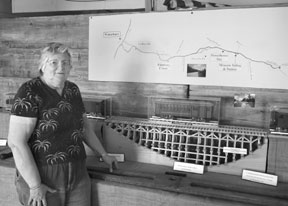Before cars zipped along Route 100, the Mt. Mansfield Electric Railroad connected Waterbury and Stowe from 1897 through 1932.
With a limited capacity — one freight car was all the train’s “box motor” could handle on steep grades — the U.S. mail and passengers fresh from the Central Vermont Railroad found their way to Stowe.
Now, that history is on track for public viewing. Jack Carter and Betty Jones, both members of the Waterbury Historical Society, are joining forces with the Stowe Historical Society to create a display on the railroad at this year’s Vermont Historical Society Expo in Tunbridge.
“I find it very fascinating that, here in rural Vermont, there was an electric railroad,” Carter said. “The roads weren’t great, and it was a way to get passengers between the two towns.”
Jones said, “If you look at some of the old pictures we have of the railroad, Route 100 was just a trail. The railroad actually ran parallel to what would become the road.”
Riding the rail
Slate grey, gold-lettered passenger cars from the electric rail met northbound passengers alighting at the Waterbury rail station.
Stowe “wasn’t what it is today, but it was certainly a destination,” Carter said.
The railroad, said Jones, “benefited Stowe much more than it did Waterbury.”
Barbara Baraw, president of the Stowe Historical Society, said state legislators envisioned the railroad in the 1880s as a means of shuttling more than passengers.
“There were a number of entrepreneurs in Stowe that needed to get their (goods) somewhere else,” she said.
From finished wood products to butter tubs filled-to-brimming for Boston, the hard-working system was a link for the booming central Vermont economy, historians said.
“The town (of Stowe) was growing, and it wasn’t just to go from Waterbury to Stowe, but to go to Morrisville,” Baraw said.
Powered by a substation abutting the Waterbury rail station, it was the little railway that could. But after years of operating at a deficit, expansion was tabled.
In the rail line’s time, it made money, at best, only one year, Carter said.
“It wasn’t a very prosperous venture,” he said.
Climbing steep slopes proved too much for the rail’s tiny power station, sometimes producing insufficient electricity for steep grades.
Clay rail beds routinely slithered into the tracks during rainstorms.
Safety of non-passengers was also a problem, as residents of Waterbury Center routinely navigated the trestle by foot, automobile, and horse-cart as a short cut to town.
But it wasn’t solely economics that cut short the life of the electric rail, according to Baraw.
“Toward the end it was faster to go by automobile,” she said. “Transportation modes changed. The intestate highway basically did us in.”
Joining forces
In its eighth year, the Vermont History Expo showcases over 150 state historical societies, museums, and heritage organizations.
Through a series of historical reenactments and displays, history comes to life, and stories are told of little-known pieces of Green Mountain history, like the Mt. Mansfield electric railroad.
“Only in Vermont — and we’re a small state — could you find enough (people) who are so proud of our history,” Carter said. “Some of the exhibits are pretty elaborate.”
Themes change each year for the expo, and last year the Waterbury Historical Society focused on Waterbury Center. Topics in previous years have included the Great Flood of 1927 and the Depression.
“We’ve had some really great exhibits,” Carter said.
Once members from the Stowe and Waterbury historical societies learned that transportation was this year’s theme, joining forces was a simple choice.
“Stowe has always wanted to do it with us,” Carter said, “so it seemed like an ideal time to collaborate.”
“That was the impetus for starting the conversation,” said Baraw, adding that the groups had been show-neighbors for years. “We just thought, ‘well, wouldn’t it be fun to do something together?’ It fell in our laps, basically.”
Two sets of replica freight and passenger cars made by the late Dr. George Rahilly, a Stowe surgeon, are showcased in the exhibit, which Carter said is surprisingly good despite a small budget.
“We use things that we have,” Carter said.
“We’ve done some pretty good exhibits,” Jones said. “Jack, of course, with his background in display because of his business (the Stowe Street Emporium), we’ve had some tremendous displays.”
“I think that this year our booth is absolutely fabulous,” said Wendy Parrish, a member of the Stowe Historical Society.
Waterbury had “the bones of a booth that, no matter what pictures we put up, it would look great,” she said, adding that the Stowe society has always done their exhibits “by the seat of their pants.”
“Waterbury is the glue this year,” Parrish said.
Carter said creating this year’s vignette was “like anything. You get to a point where you say ‘I’m sick of this,’ but then it clicks.”
Baraw said the group quickly found common ground; Waterbury’s investment in reusable props made quick work of the display.
All agree future collaboration between the two groups is a possibility, as long as the subject is relevant.
“If something that’s connected would come up, we could work together we’ve got so many ideas of things to do,” Jones said.
Baraw said it would be fun, but “I’m not sure what the project might be.”
“We want to get through this one,” she said, laughing. “We’re tired.”













(0) comments
Welcome to the discussion.
Log In
Keep it clean. Please avoid obscene, vulgar, lewd, racist or sexual language.
PLEASE TURN OFF YOUR CAPS LOCK.
Don't threaten. Threats of harming another person will not be tolerated.
Be truthful. Don't knowingly lie about anyone or anything.
Be nice. No racism, sexism or any sort of -ism that is degrading to another person.
Be proactive. Use the "Report" link on each comment to let us know of abusive posts.
Share with us. We'd love to hear eyewitness accounts, the history behind an article.